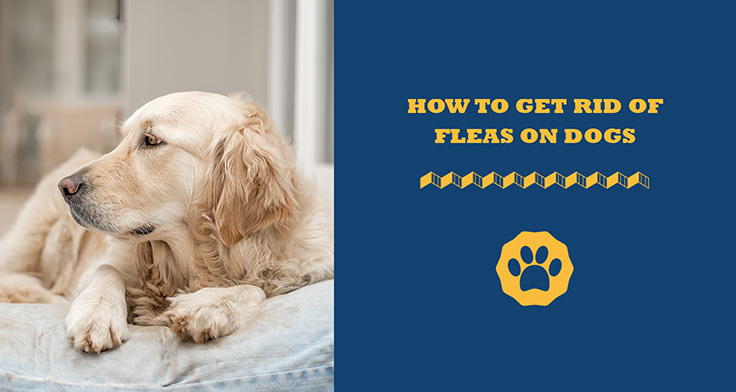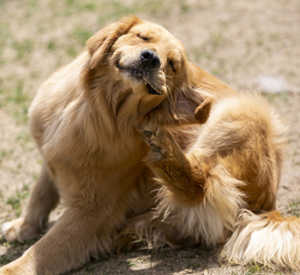Updated: November 11th, 2022
This article contains affiliate links. Read the full disclosure here.

You may be the most careful and responsible pet parent, but that still may not be enough to save you from the dreaded “F word”: Fleas. Just like mosquitos, they will persist and work hard until they get a bite. Fortunately, although they’re persistent, fleas can be managed, and this article covers how to get rid of fleas on dogs and keep them away for good.
It’s not easy, to be honest, but since pet owners have been dealing with fleas for many years, you don’t have to overwhelm yourself with solutions that may not yield the results you desire.
Talking to seasoned vets and fellow pet parents and combing through forums and studies helped me to figure out what works for my dogs. I’ll share the results with you today. But before I get to that, first, let’s learn a few things about these pesky blood-sucking creatures that will help you fight them properly.
The Flea Life Cycle
Fleas go through four life stages before turning into adults. This can happen very quickly or last months or even years. It all depends on the environmental conditions.
Understanding these life stages is essential as a pet parent. You might just be able to avert a disaster and keep your dogs flea-free.
Stage 1: Egg
Female adult fleas begin to lay eggs soon after they feed on blood from a host. They typically lay eggs in groups of about 20, which they quickly spread over the environment where the host spends most of their time.
Hatching could take place after a few days or weeks, depending on how favorable the environment is, setting the stage for the next phase of life: larva.
Stage 2: Larva
Larvae are white in colour (almost transparent), blind, and hate light. At this point, these tiny creatures feed on flea dirt and debris to sustain their growth. In around 5 to 20 days after hatching, they will start to form a cocoon.
Stage 3: Pupae
Cocoons usher in the pupae stage. This silky envelope protects the pupae until the conditions are perfect for the adult to emerge and begin reproducing once more. Vibrations, heat, and carbon dioxide are the sort of “green lights” for them to come out and meet their victims.
Stage 4: Adult
Adult fleas will surface at this point and jump onto their first victim within a few hours. From here on, they will be feeding on blood from host to host until they are strong enough to reproduce once more (or end up dying an untimely death if their host has proper flea preventative medication).
The Causes For Fleas On Dogs
Fleas prefer to spend their lives outdoors, especially in cool, moist, shaded places. You may spot them on trees, leaves, shrubs, and, of course, animals. It’s therefore easy for your dog to pick them up. Here’s how this could happen:
- Contact with other animals
- Flea infestation at your home
- Visits to pet facilities such as daycare, boarding kennels, dog grooming and vaccination places, and so on
- Being in outdoor areas, like the kennel, yard, or park
- Visits to warmer regions where fleas thrive
In other words, the chances of your dog picking up fleas are high, whether she spends most of her time at home or plays outside a lot. Fleas could be lying in wait anywhere!
Signs Of Fleas

Once in a while, your dog will scratch, probably because a part of its body feels itchy. But when she goes overboard with it, you should treat that as urgent. Biting is how fleas announce their arrival, and those bites are itchy!
These are the key signs your dog may be dealing with a flea problem:
- Excess scratching and itching
- Additional biting and chewing at their skin
- Presence of fleas and flea dirt
- Hair loss
- Redness or scrubbing
For dogs with flea allergy dermatitis (FAD), the experience is worse. For dogs with FAD, flea saliva triggers an allergic reaction that intensifies the symptoms and causes other painful conditions. And that’s not where it ends.
Severe flea infestation means your dog will lose a lot of blood. This inevitably leads to anaemia, which is most often visible through pale gums. Bacterial infections could occur as well, not to mention tapeworms.
You don’t want your dog in either of these states because it’s uncomfortable and excruciating for them. This leads us to the next topic at hand: how do you deal with these bloodsuckers?
How To Get Rid Of Fleas On Dogs: The Different Types Of Treatment
You may be tempted to go for just any over-the-counter treatment you find, such as powders, pills, flea shampoo, and flea collars, but without expert knowledge, you won’t know which option truly is best for treating your pet.
As soon as you spot flea bites on your dog, talk to your vet. Let them examine your pup and establish which treatment path to follow. Several factors will have to be considered, from possible side effects to your dog’s existing health conditions.
That said, these are the different types of flea treatment available today (complete with some top recommendations) for putting these bloodsuckers to death.
Oral Medications:
Powders for carpets:
As you battle fleas eggs on dogs, don’t forget the ultimate treatment lies in prevention. It’s the best way to stop these little bloodsuckers in their tracks.
How To Prevent Fleas
Fleas are relentless. Even with just a 14-day lifespan, they don’t stop showing up; instead, they keep on multiplying. Can you stop them? Of course. It’s actually easier to keep these parasites out of your house than it is to remove them.
How To Treat Your House For Fleas
To keep fleas out of your home, start with these simple hacks:
- Regularly sweep and vacuum your carpet, floors, rooms, and furniture and dispose of the dirt with care
- Thoroughly wash your dog bedding and items in hot, soapy water regularly
- Routinely steam clean all the furniture and carpets in your house
These are the main ways you can keep parasites out of your house. Still, you can always go the extra mile and use flea control products to double up the chances of a flea not surviving in your home.
If you’re reluctant to use pest control products, this may not be the most favorable option to you.
Is that you? Don’t fret just yet. There are plenty of natural remedies you can still use to keep parasites away from your home. Some of the best home remedies for fleas on dogs include:
- Flea repelling plants like catnip, citronella, eucalyptus, lavender or chamomile
- Diatomaceous Earth
- Natural dog shampoo
- Natural flea spray (made by mixing vinegar, water, lemon juice and witch hazel)
Additionally, regular baths and grooming with a flea comb will help keep your dog flea-free.
Treating Fleas On Puppies

Fleas aren’t picky; they will attack both puppies and adult dogs. At six months old, your dog’s immune system will be at its peak, meaning she can put up a spirited fight against the conditions caused by these pesky parasites.
Puppies, unfortunately, have weaker immune systems, making them more vulnerable to flea-related health problems such as anemia, respiratory issues, and in worst cases, death.
Refer to the symptoms above while looking after your dog. As soon as you spot the fleas or the signs of a flea infestation, take her to the vet right away. Some of the treatments we mentioned can be too harsh or dangerous for them, so only a vet can figure out the best treatment method for your puppy.
FAQs On How To Get Rid Of Fleas
Where Do Fleas Come From?
Fleas start out as eggs in warm, moist, shady environments where they develop into adults before spreading out further to their surroundings. Dogs and cats are their primary hosts, but other animals too, including humans, could accommodate these bloodsuckers.
Once they grow into adults, fleas will begin to jump from one host to another. Your dog could easily pick them up while out there and transfer them into your house where the growth cycle continues, and before you know it, your home is invested.
What Is Flea Dirt?
Feces from adult fleas are known as flea dirt. Because blood is their primary food, this “dirt” is basically digested blood, dark in color and grainy. When your dog has been infested by fleas, this dirt will be all over the places where she spends most of her time.
It’s easy to miss them, but if your dog’s bedding or fur is bright in color, the dirt will be totally visible. If you think the grains could be something else, just place them on a piece of wet paper towel. If the grain does not stain it, then it probably isn’t flea dirt.
How Do I Know If My Dog Has Fleas?
To spot flea eggs on dogs, first, you have to brush and groom them regularly. Look out for flea dirt, and also check your dog’s brushes for any fleas. Fleas are tiny, brown, and easy to detect with your eyes.
Closely examine your dog’s skin as well. If it’s reddish and bumpy, that’s a sign she’s been scratching a lot, and it could be due to fleas.
How Long Does It Take To Get Rid Of Fleas?
Unfortunately, there’s no standard time that fleas take to clear up from your pet or environment; this is a process that largely depends on how long they’ve been there and the existing conditions.
A topical treatment or quick cleaning may get rid of them in one to two days. But for all the fleas to be completely wiped out from your environment, you may have to wait for weeks or longer because of their complex life cycle.
It’s recommended that you repeat the cleaning and treatments at least twice within a week in order to reduce their survival chances further.
How To Kill Fleas On Dogs (In A Nutshell)
Fleas, as you may have noticed, are an inevitable occurrence, especially for pet owners. Your home can be pest-free today but not the day after. A lot could happen within just a few hours, regardless of whether your pet stays indoors or goes roaming outdoors often.
The good news? You can easily keep these pesky little creatures from ever surviving in your house or on your pet by taking preventative measures. Here’s how to get rid of fleas in dogs in summary:
- Vacuum and clean everything in your house regularly
- Look after your pet every day if possible by combing and grooming her
- Have a vet’s phone number on speed dial for prompt treatment
Also, don’t forget there are still plenty of natural treatments out there for those eager to know how to get fleas off dogs without harming yourself or the environment.



